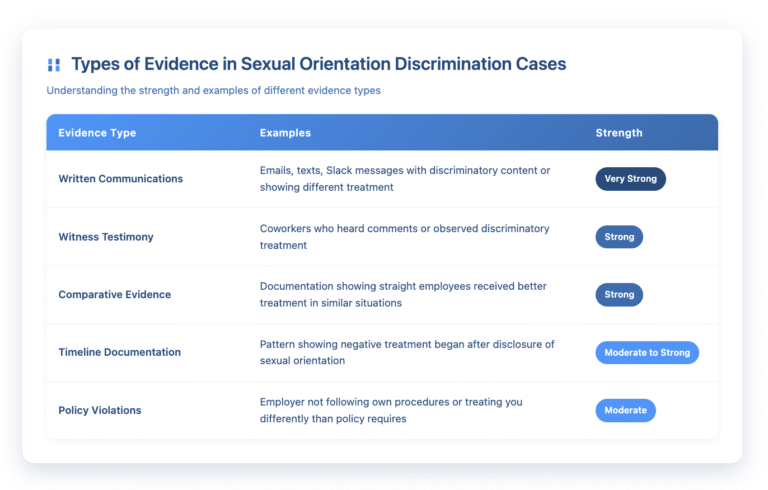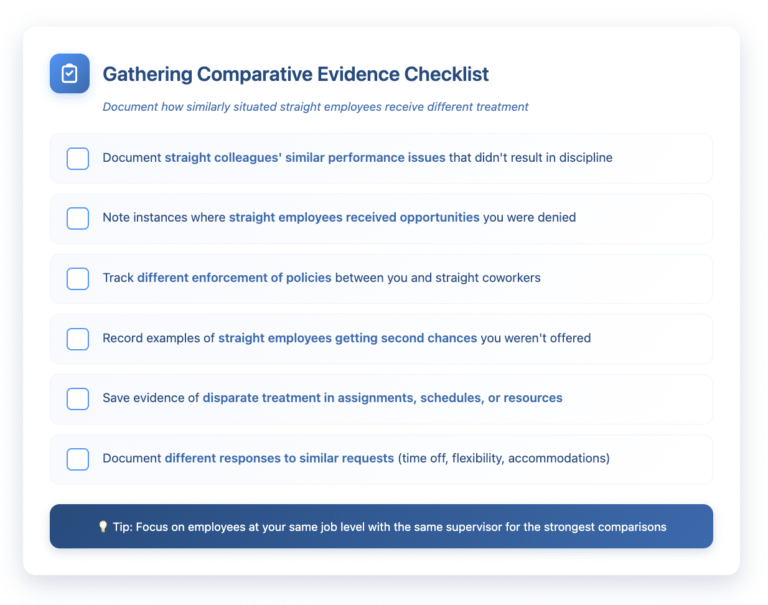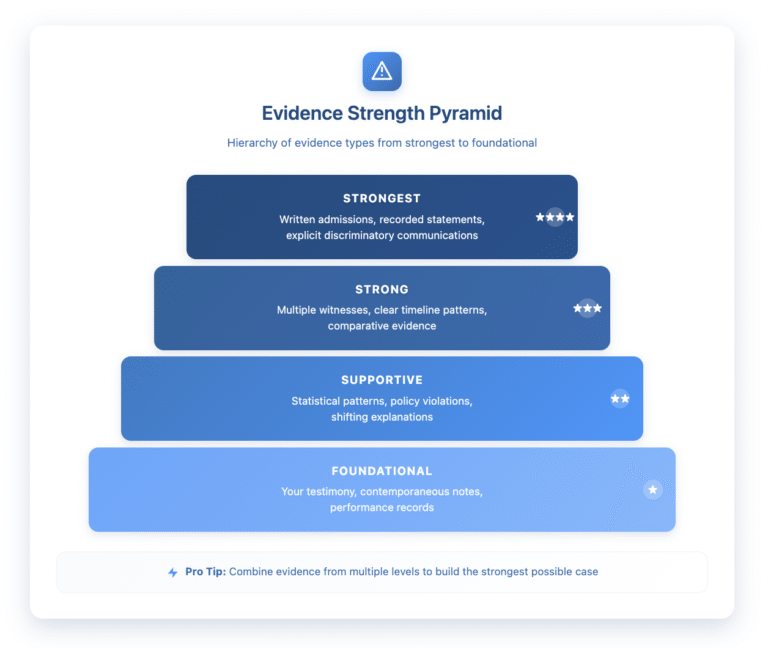If you suspect you’re being discriminated against at work because of your sexual orientation, you’re probably wondering what it takes to prove it legally. The truth is, discrimination rarely comes with a smoking gun. Nobody’s going to write “fired for being gay” on your termination paperwork.
But that doesn’t mean you can’t build a strong case. You just need to understand what evidence matters and how to document the discrimination you’re experiencing. Let’s walk through exactly what you need to prove sexual orientation discrimination and the concrete steps you can take starting today.
Disclaimer: This article provides general information for informational purposes only and should not be considered a substitute for legal advice. It is essential to consult with an experienced employment lawyer at our law firm to discuss the specific facts of your case and understand your legal rights and options. This information does not create an attorney-client relationship.
Understanding Your Legal Foundation
Thanks to the Supreme Court’s 2020 decision in Bostock v. Clayton County, sexual orientation discrimination is now clearly illegal under federal law. Title VII of the Civil Rights Act protects you from employment discrimination based on who you love, period.
This protection covers every aspect of your employment – hiring, firing, promotions, pay, job assignments, training opportunities, and benefits. It applies whether you’re gay, lesbian, bisexual, pansexual, or identify with any other sexual orientation.
State and Local Protections Matter Too
While federal law now provides baseline protection, many states and cities offer even stronger safeguards. New York State Human Rights Law, for example, provides broader protections and longer filing deadlines than federal law.
These additional protections can make a real difference in your case. They might give you more time to file, allow for greater damages, or cover smaller employers that federal law doesn’t reach.
The Two Paths to Proving Discrimination
Sexual orientation discrimination typically shows up in two ways: direct evidence and circumstantial evidence. Understanding both helps you recognize and document discrimination as it happens.
Direct Evidence: When Bias Shows Its Face
Direct evidence is discrimination that’s obvious and explicit. Think comments like “we need a straight person for this client-facing role” or “this company isn’t ready for an openly gay manager.”
These statements don’t require any inference or interpretation. They directly show that sexual orientation factored into an employment decision. While powerful, direct evidence has become less common as employers have gotten savvier about avoiding explicit discrimination.
Circumstantial Evidence: Reading Between the Lines
Most discrimination cases rely on circumstantial evidence – a pattern of facts that, taken together, suggest discrimination. This might include sudden performance issues after coming out, different treatment compared to straight colleagues, or shifting explanations for adverse employment actions.
Courts recognize that discrimination often hides behind legitimate-sounding reasons. Your job is to show that these reasons don’t add up.
Building Your Evidence Framework

Establishing Your Prima Facie Case
To move forward with a discrimination claim, you need to establish what lawyers call a “prima facie case.” This means showing:
- You belong to a protected class (your sexual orientation)
- You were qualified for your position or met legitimate job expectations
- You suffered an adverse employment action
- The circumstances suggest discrimination
Once you establish these elements, the burden shifts to your employer to provide a legitimate, non-discriminatory reason for their actions. Then you need to show their reason is just a cover-up for discrimination – what courts call “pretext.”
Documenting Discrimination: Your Action Plan
Start Your Evidence File Today
Create a dedicated folder (physical or digital) for all discrimination-related documentation. Keep this separate from your work computer or email, as you may lose access to those suddenly.
Every incident matters, even if it seems minor. Small slights and microaggressions can establish a pattern of discriminatory treatment when viewed together.
Master the Art of Contemporaneous Notes
The most credible evidence is created in real-time. After any incident, write down:
- Date, time, and location
- Everyone present or within earshot
- Exact words used (not paraphrasing)
- Your response and others’ reactions
- Any witnesses who might have observed the incident
Email these notes to yourself at a personal email address. This creates a time stamp that proves you documented events as they happened, not months later when preparing a complaint.
Preserve Electronic Communications
Save every relevant email, text, or instant message. Forward work emails to your personal account (if your company policy allows) or take screenshots. Include the full email chain to show context.
Pay special attention to communications that show:
- Different treatment after disclosing your sexual orientation
- Comments about your personal life or relationships
- Exclusion from meetings, projects, or social events
- Sudden criticism of previously acceptable work
Comparative Evidence: Your Secret Weapon
One of the strongest ways to prove discrimination is showing that similarly situated straight employees received better treatment. This requires strategic observation and documentation.

Finding Your Comparators
The key is identifying coworkers who are truly “similarly situated” – same job level, similar experience, same supervisor, comparable performance history. Courts look closely at whether your comparators are actually comparable.
Document everything about these comparators: their qualifications, performance reviews, any disciplinary history, and most importantly, how they were treated differently than you.
Timeline Evidence: Connecting the Dots
Discrimination often follows a predictable pattern. Your treatment changes after a specific triggering event – usually when your employer learns about your sexual orientation.
Mapping Your Timeline
Create a visual timeline showing:
- When you started experiencing negative treatment
- When your sexual orientation became known at work
- Each adverse action taken against you
- Any relevant comments or incidents
This timeline becomes powerful when it shows a clear “before and after” pattern. Excellent performance reviews followed by sudden criticism after coming out tell a compelling story.
Addressing Counter-Arguments
Your employer will likely claim their actions were based on legitimate business reasons – performance issues, restructuring, or policy violations. Your job is to show these reasons don’t hold water.
Exposing Pretext
Look for evidence that the employer’s stated reason is false:
- Inconsistent explanations for the same decision
- Reasons that don’t match documented facts
- Policies applied to you but not others
- Timing that suggests discrimination
- Statistical patterns showing bias
Document every shifting explanation. If your termination reason changes from “performance” to “attitude” to “restructuring,” that inconsistency suggests the real reason hasn’t been disclosed.
Working With Witnesses
Witnesses can make or break your case, but getting coworkers to speak up requires careful handling. Many fear retaliation or simply don’t want to get involved.
Approaching Potential Witnesses
Start with those most likely to support you – people who’ve expressed concern about your treatment or witnessed specific incidents. Be factual, not emotional, when discussing what you need from them.
Ask witnesses to write down what they observed while it’s fresh. Even if they won’t testify later, their contemporaneous statements have value. Get their personal contact information in case they leave the company.

Understanding Employer Defenses
Knowing what defenses your employer might raise helps you gather evidence to counter them. Common defenses include:
The “We Didn’t Know” Defense
Employers often claim they couldn’t discriminate based on sexual orientation because they didn’t know about it. Counter this by documenting when and how your orientation became known – whether through direct disclosure, office conversations, or social media.
The “Equal Opportunity Offender” Defense
Some employers argue they treat everyone badly, not just LGBTQ+ employees. Document how the bad treatment specifically relates to sexual orientation or shows a pattern affecting LGBTQ+ workers disproportionately.
The “Business Necessity” Defense
Employers might claim their actions were essential for business operations. Gather evidence showing the business could have achieved its goals without discriminatory treatment or that the reason is a pretext.
Maximizing Your Legal Position
Internal Complaints: Creating a Paper Trail
Filing an internal complaint serves multiple purposes. It puts your employer on notice, potentially triggers their duty to investigate, and creates evidence of protected activity if you face retaliation.
Write your complaint clearly and professionally. Stick to facts, not emotions. Include specific examples and identify witnesses. Keep a copy for your records and send it via email for a timestamp.
EEOC Charges and State Agency Filings
You typically have 180 days from the discriminatory act to file with the EEOC (300 days in states with fair employment agencies). These deadlines are strict – missing them can kill your case.
Filing triggers an investigation and preserves your right to sue. Even if the agency doesn’t find discrimination, you get a “right to sue” letter that opens the courthouse door.
When Retaliation Enters the Picture
Retaliation often follows discrimination complaints. Document any negative changes after you report discrimination:
- Increased scrutiny or criticism
- Exclusion from meetings or projects
- Schedule changes or assignment shifts
- Cold shoulder treatment from management
- Sudden performance improvement plans
Retaliation claims can be easier to prove than the underlying discrimination and carry the same legal remedies.
Building Your Support Network
Fighting discrimination takes an emotional toll. Build a support system that includes:
- LGBTQ+ employee resource groups
- Local LGBTQ+ advocacy organizations
- Trusted friends and family members
- Mental health professionals familiar with discrimination trauma
Document how discrimination affects your mental and physical health. This evidence supports damage claims for emotional distress.
Calculating Your Damages
Understanding potential damages helps you evaluate settlement offers and litigation strategies. Sexual orientation discrimination cases may recover:
- Back pay (lost wages and benefits)
- Front pay (future lost earnings)
- Compensatory damages (emotional distress, pain, and suffering)
- Punitive damages (to punish egregious conduct)
- Attorney’s fees and costs
Keep records of all financial losses, including job search expenses, medical costs, and therapy bills related to the discrimination.
Taking Action: Your Next Steps
Don’t wait for discrimination to escalate before taking action. The earlier you start documenting and seeking help, the stronger your position becomes.
Review your employee handbook and company policies. Many employers have anti-discrimination policies that go beyond legal requirements. Violations of these policies strengthen your case.
Consider whether you’re ready to proceed internally, file an agency charge, or need legal guidance first. Each path has advantages and time limitations you need to understand.
Time Limits Matter
Discrimination claims have strict deadlines:
- Internal complaint deadlines (check your employee handbook)
- EEOC filing: 180-300 days, depending on your state
- State agency deadlines: vary by state
- Lawsuit filing: 90 days after receiving your right-to-sue letter
Missing these deadlines can bar your claim forever, regardless of how strong your evidence is.
Protecting Yourself While Building Your Case
Continue performing your job well despite the discrimination. Document your good performance to counter any pretextual performance claims.
Avoid giving your employer legitimate reasons for discipline. Follow policies, meet deadlines, and maintain professionalism even when facing unfair treatment.
Keep your evidence gathering discreet. Don’t announce your plans to sue or openly collect evidence in ways that might provoke pretextual retaliation.
Why Legal Representation Matters
Employment discrimination law is complex, with procedural requirements that can trap the unwary. An experienced attorney can:
- Evaluate your evidence objectively
- Identify claims you might have missed
- Navigate filing requirements and deadlines
- Negotiate with the employer’s counsel
- Maximize your potential recovery
The right legal strategy depends on your specific situation, evidence strength, and personal goals.
Take the First Step Today
If you’re facing sexual orientation discrimination, you don’t have to navigate this alone. Understanding how to prove discrimination is just the beginning – taking action to protect your rights is what matters.
Start documenting everything today. Build your evidence file. Note your timeline. Identify your witnesses. The steps you take now directly impact your ability to achieve justice later.
Ready to discuss your sexual orientation discrimination case? Contact Nisar Law Group for a consultation. We’ll review your evidence, explain your options, and help you understand the best path forward for your situation. Don’t let discrimination define your career – let’s work together to protect your rights and hold discriminatory employers accountable.


